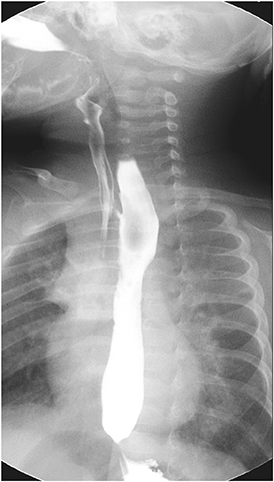Adv Pediatr Surg.
2018 Dec;24(2):94-99. 10.13029/aps.2018.24.2.94.
Double H-type Tracheoesophageal Fistulae: A Case Report
- Affiliations
-
- 1Department of Pediatric Surgery, Ajou University School of Medicine, Suwon, Korea. hongj@ajou.ac.kr
- KMID: 2429806
- DOI: http://doi.org/10.13029/aps.2018.24.2.94
Abstract
- We present an extremely rare case with double H-type tracheoesophageal fistulae identified with a time-lapse and repaired separately. A newborn male presented with cyanosis after breastfeeding. Contrast esophagogram demonstrated an H-type fistula, and then it was repaired in a standard fashion via right thoracotomy. When routine esophagogram was taken on postoperative day 10, another fistula was noticed at a level higher than the previous one. Bronchoscopy was performed to evaluate the lesion whether it was a recurred fistula or a second H-type fistula. However, it was so tiny that it was not visible with bronchoscopy. It was discovered only two months later when the fistula had grown up with the baby. The second H-type fistula was repaired through a cervical incision. Although double H-type fistulae are extremely rare, the possibility of another fistula, as well as recurrence, must be ruled out when symptom recurs after a definitive operation of an H-type fistula.
Keyword
MeSH Terms
Figure
Reference
-
1. Mattei P. Double H-type tracheoesophageal fistulas identified and repaired in 1 operation. J Pediatr Surg. 2012; 47:e11–3.
Article2. Schulte T, Ankermann T, Claas A, Engler S. An extremely rare abnormality of a double tracheoesophageal fistula without atresia of the esophagus; a case report and review of the literature. J Pediatr Surg. 2009; 44:e9–e12.
Article3. Amat F, Heraud MC, Scheye T, Canavese M, Labbé A. Flexible bronchoscopic cannulation of an isolated H-type tracheoesophageal fistula in a newborn. J Pediatr Surg. 2012; 47:e9–e10.
Article4. Slater BJ, Rothenberg SS. Tracheoesophageal fistula. Semin Pediatr Surg. 2016; 25:176–178.
Article5. Leven NL, Varco RL, Lannin BG, Tongen LA. The surgical management of congenital atresia of the esophagus and tracheo-esophageal fistula. Ann Surg. 1952; 136:701–719.6. Cho HD, Nam SH, Cho MJ, Kim TH, Kim DY, Kim SC, et al. Clinical experience of H-type tracheoesophageal fistula. J Korean Assoc Pediatr Surg. 2011; 17:154–161.
Article7. Fallon SC, Langer JC, St. Peter SD, Tsao K, Kellagher CM, Lal DR, et al. Congenital H-type tracheoesophageal fistula: a multicenter review of outcomes in a rare disease. J Pediatr Surg. 2017; 52:1711–1714.
Article8. Helmsworth JA, Pryles CV. Congenital tracheo-esophageal fistula without esophageal atresia. J Pediatr. 1951; 38:610–617.
Article9. Andrassy RJ, Ko P, Hanson BA, Kubota E, Hays DM, Mahour GH. Congenital tracheoesophageal fistula without esophageal atresia. A 22 year experience. Am J Surg. 1980; 140:731–733.10. Rothenberg S. Esophageal atresia and tracheoesophageal fistula malformations. In : Holcomb GW MJ, Ostlie DJ, editors. Ashcraft's pediatric surgery. 6th ed. London: Elsevier Saunders;2014. p. 365–384.11. Harmon C, Coran A. Congenital anomalies of the esophagus. In : Coran A, Adzick N, Krummel T, Laberge J, Shamberger R, Caldamone A, editors. Pediatric surgery, volume 2. 7th ed. Philadelphia (PA): Elsevier Saunders;2012. p. 893–918.12. Garcia NM, Thompson JW, Shaul DB. Definitive localization of isolated tracheoesophageal fistula using bronchoscopy and esophagoscopy for guide wire placement. J Pediatr Surg. 1998; 33:1645–1647.
Article
- Full Text Links
- Actions
-
Cited
- CITED
-
- Close
- Share
- Similar articles
-
- Congenital Tracheoesophageal Fistula in an Adult
- Esophageal Atresia with Double Tracheoesophageal Fistula: A Case Report
- A case of agenesis of the right lung with H-type tracheoesophageal fistula
- Congenital tracheoesophageal fistula with no esophageal atresia (H-type) in adult
- A Case of the Esophageal Atresia with Distal Tracheoesophageal Fistula Associated with Duodenal Obstrction





